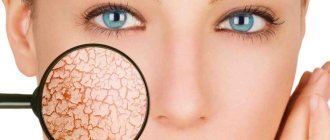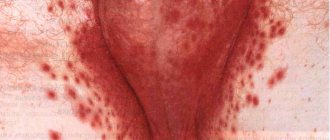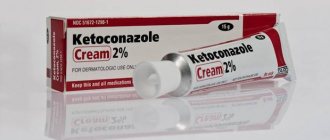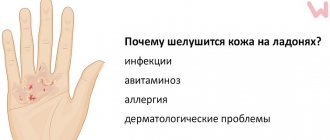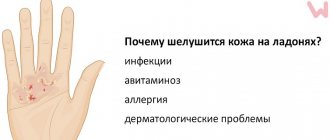This article will talk about what to do if you have flaky, itchy skin on your legs. What are the causes of this condition, and what in this case will help get rid of itching and flaking?
Almost everyone knows what itching in the lower extremities is. Such sensations often arise due to the influence of external factors. Therefore, you don’t always need to worry about this. However, when the skin on your legs peels and itches, you should pay attention to these symptoms. It is better not to let the disease progress and immediately consult a specialist to establish a diagnosis. Then undergo a course of treatment.
Problem
Itchy skin can appear on any part of the body, but most often we experience it on the skin of the arms and legs.
It can begin at any time of the day, but it is especially unpleasant to experience itching at night, when it is most difficult for us to resist the urge to scratch the itchy area.
In addition, when we rest, the body produces less adrenaline and cortisone, but there is an increase in the production of the hormone histamine, which makes us feel itching even more. It can become a symptom of the development of an infection, in particular, foot fungus .
What can cause itching
Among the most common causes of itching, it is worth mentioning excessive dry skin, which leads to the fact that the skin on the legs begins to peel. If no rashes appear on the skin, then this is perhaps the most important cause of itching.
It can also be caused by excessive sweating of the feet and very damp skin.
The appearance of a rash may indicate an allergy (allergic contact dermatitis) to clothing, medications, cosmetics, or chemicals, so if you notice a rash, you can try using a different laundry detergent, soap, or wearing clothes of other materials.
In addition, the rash can be a symptom of a fungal infection (for example, athlete's foot) or indicate eczema, dermatitis or psoriasis.
- Eczema is a disease that causes skin cells to become inflamed and cause severe itching. With eczema, cracks appear on the skin, they become inflamed, and blisters may appear. Some researchers believe that people with eczema have spaces between their skin cells that allergens happily take advantage of.
- The appearance of dermatitis can be explained by several reasons, but it is always a reaction of the skin to excessive dryness , allergens and irritation. Chronic dermatitis can be caused by a bacterial infection because cracks in the skin may appear as the dermatitis progresses.
- Toenail fungus is a fungal infection that usually begins to develop in the space between the toes. Symptoms of fungus can include itching, red rashes, which, if left untreated, can spread to the entire foot. With further development of the infection, the skin may crack, which also brings discomfort.
- It is believed that psoriasis is an autoimmune disease, but it is unlikely that anyone can accurately name its cause. It usually develops when, under normal conditions, the immune system begins to react as if it is defending itself against threats. Symptoms of psoriasis include skin redness, blistering and flaking.
Reasons usually include:
- bacterial or viral infection;
- diseases that weaken the immune system;
- stress;
- sudden change in weather;
- taking certain medications;
- cuts, burns and abrasions.
Dermatitis on legs
Venous dermatitis on the legs
Varicose dermatitis on the lower legs occurs as a result of trophic disorders.
It develops against the background of chronic uncompensated lymphovenous insufficiency.
Women suffer from this pathology 3 times more often than men.
Pathology usually occurs after 40 years.
Venous dermatitis often occurs on the legs during pregnancy.
This is due to an increase in the volume of circulating blood and a decrease in the tone of the veins due to hormonal changes.
The pregnancy hormone progesterone increases the permeability and distensibility of the venous wall.
Which leads to varicose veins and deterioration of blood supply to the skin of the lower extremities.
Varicose eczematous dermatitis on the legs does not develop instantly.
If the cause is not thrombosis or injury, and the pathology occurs against the background of varicose veins, then this process lasts for years.
Its appearance is promoted by venous stagnation.
Initially, signs of skin thickening appear, hair falls out, and swelling is observed.
Only after some time does stasis dermatitis occur.
Upon examination, the doctor discovers dilated veins.
The skin is atrophic, dry, thin, hyperpigmented.
Varicose eczema can spread to other parts of the body as the body becomes sensitized.
White plaques may appear on the skin.
Against their background, varicose ulcers develop - they are very painful.
In vascular dermatitis on the legs, the subcutaneous tissue is thickened.
Against this background, warty growths of the epidermis are possible.
Dry dermatitis on legs
Older people often develop dry dermatitis.
At risk are men over 65 years of age.
Pathology most often occurs in the winter season, while remission is observed in the summer.
The main localization of this type of dermatitis is the lower legs.
Upon examination, the doctor discovers dry skin.
Peeling is possible.
The disease has a chronic, long-term course.
The inflammatory process can last from several weeks to several months.
Very often, the disease develops against the background of constant degreasing of the skin - regular washing with soap.
Dry warm air also contributes to dry dermatitis.
To prevent the occurrence of the disease, older people should avoid frequent use of soap.
You should bathe more often in the shower rather than in the bath.
And also maintain the air humidity in the room where they spend most of their time at a level of at least 50%.
Seborrheic dermatitis on the legs
Seborrheic dermatitis occurs in areas where there is hair.
There are quite a lot of them on the legs, so the lower limbs are at risk.
Pathology can occur in people of any age, including children.
Men get sick more often.
Seborrheic dermatitis is not genetically transmitted, but there is a hereditary predisposition to it.
This disease is chronic with an undulating clinical course.
Periods of exacerbation and remission follow each other.
Usually there is an improvement in the summer, and an exacerbation in the fall.
People who suffer from seborrheic dermatitis are better off wearing shorts rather than trousers in the warmer months.
Because ultraviolet rays reduce the manifestations of the disease and prevent exacerbations.
Typically, the rash elements of seborrheic dermatitis look like greasy or dry patches with peeling.
These can also be large papules measuring 1-2 cm, with clear boundaries.
It may become wet and cracks may appear.
Infectious dermatitis on the legs
Sometimes skin inflammation is caused by infections.
The causative agents can be fungi, bacteria, viruses.
Frequent causative agents of skin infections are staphylococci and streptococci.
Infectious dermatitis may be accompanied by suppuration.
Upon examination, the doctor discovers:
- purulent crusts;
- continuous arrangement of morphological elements of the skin without layers of healthy skin;
- increase in lesions along the periphery;
- the presence of single papules or pustules around the main focus of infection.
There are a wide variety of infections that can affect the skin.
In each case, the symptoms will be different.
How to treat dermatitis on the legs
Treatment for dermatitis on the legs can vary depending on the type of disease.
Acute simple contact dermatitis (the result of a chemical burn) usually goes away on its own.
Treatment is not required - the manifestations of the disease disappear without any residual effects.
But in severe clinical cases, medical assistance may be needed.
It consists of treating the affected skin with antiseptic solutions.
This is required to prevent the addition of bacterial inflammation.
If there are large bubbles, they are punctured, but the tire is not removed.
To reduce symptoms - pain, itching, burning, swelling - weak local glucocorticoids are prescribed.
For severe inflammation, oral corticosteroids are prescribed.
For acute allergic dermatitis, the treatment is similar.
It is important to identify the allergen and avoid contact of the skin of the feet with it.
In cases of subacute or chronic allergic dermatitis, ointments with potent glucocorticoids are prescribed.
Oral corticosteroids may be used.
With atopic dermatitis, the main goal of treatment is to avoid further scratching of the skin.
Lotions with camphor or menthol help relieve itching.
These drugs have a distracting effect.
In the acute stage, ointments with corticosteroids are used to treat atopic dermatitis.
To prevent the addition of a secondary bacterial infection, use local medications with antibiotics.
For severe itching, take oral antihistamines.
When a secondary bacterial infection occurs, antibiotic tablets are prescribed.
It is possible to use intestinal sorbents internally to remove toxic metabolic products.
In the treatment of cold dermatitis, plasmapheresis is used to cleanse the blood of circulating immunoglobulins.
For kidney damage, cyclophosphamide is prescribed.
For inflammation of the skin and joints, non-steroidal anti-inflammatory drugs are indicated.
Treatment of venous dermatitis on the legs is carried out with the help of hormonal drugs.
Triamcinolone is administered locally.
It is important to avoid injury to the affected areas.
Treatment of the underlying disease – varicose veins – is required.
Sclerotherapy or surgery can be used for this.
Before radical treatment, a person wears tight bandages for the treatment of blood vessels or compression stockings, and takes venotonics (diosmin).
In the treatment of dry dermatitis, effective ointments containing vegetable oils are used.
You should install a humidifier in the bedroom.
You can take warm baths with added oils.
Foretal cream gives good results.
In cases of severe inflammation, corticosteroids of moderate strength are used.
They are used 2 times a day.
Hormones are canceled after the cracks in the skin disappear.
In the treatment of seborrheic dermatitis on the legs, drug and non-drug methods are used, depending on the severity of the pathology.
The patient is advised to spend more time in the sun.
Irradiation with an ultraviolet lamp can be carried out.
When a fungal process is attached, creams with ketoconazole are used.
Corticosteroid ointments (hydrocortisone) 2 times a day may be prescribed.
For maintenance therapy, 2% salicylic acid is used.
Non-hormonal cream Naftaderm is used.
Hydrocortisone may also be prescribed for maintenance treatment.
But in this case, regular medical examinations are required in order to promptly identify signs of incipient skin atrophy.
In the case of infectious dermatitis, identification of the pathogen is required
Then treatment is carried out with antibiotics, antimiotics or antiviral drugs.
The lesion is treated with antiseptic solutions.
For suppuration, broad-spectrum antibiotics (erythromycin, ceftriaxone, etc.) are indicated.
Alternative treatment for dermatitis on the legs
Some patients try to treat at home with folk remedies.
This approach is doomed to failure.
In folk medicine, all dermatitis is treated with the same means - without any diagnosis.
In addition, all the recipes used are ineffective.
In the best case, a person will be lucky and the dermatitis will go away on its own.
At worst, complications will arise as a result of an allergy to folk remedies or the spread of an infectious process.
Many dermatitis are dangerous to human health and life.
Therefore, treatment should only be done by a doctor.
What tests should I take?
It is not always possible for a doctor to clinically determine the origin of dermatitis.
After all, many inflammatory processes have similar external manifestations.
Therefore, tests are often required for dermatitis.
Basic laboratory tests that are used:
- Skin patch tests with allergens - to confirm allergic contact dermatitis.
- Allergic blood tests for immunoglobulins E.
- Scraping for fungus.
- Culture for infections.
- Dermatoscopy.
- Skin biopsy.
- Doppler testing of blood vessels for suspected varicose veins.
Which doctor should I contact?
If signs of dermatitis appear, you should consult a dermatologist or dermatovenerologist.
This specialist deals with skin diseases.
Good dermatologists work in our clinic.
You can contact one of them.
The doctor will find out the cause of dermatitis, its origin, and conduct targeted therapy.
It will be aimed not only at eliminating the symptoms of pathology.
But also to eliminate the main pathogenetic and etiological factors that led to inflammation.
This is required to ensure that dermatitis does not return in the future after treatment is completed.
If dermatitis appears on your legs, contact the author of this article, a dermatologist in Moscow with 15 years of experience.
How to stop itching
The difficulty is to break the vicious circle of itching/scratching, and this is not at all as easy as it seems.
Cold showers, baths, and ice packs can help numb the itching.
Moisturizing should be the first step to getting rid of eczema, as moisture can help block the spaces between skin cells where allergens multiply. You can also use one of the over-the-counter medications to treat your symptoms.
If the itching continues to haunt you, it is recommended to consult a doctor.
The skin on your legs is peeling - what to do?
To eliminate the factors that provoke this reaction, you will need to first consult a medical specialist. Timely treatment will always be more effective than a protracted illness. And even better, in order not to experience such problems, engage in prevention. And carry out hygiene procedures, play sports.
Why does the skin on my legs die?
If the skin on your legs is very flaky and itchy, then first of all, observe hygiene requirements. Choose natural socks or tights made of cotton threads. Keep your feet clean, apply a nourishing, rich cream to your feet at night to prevent the skin from flaking.
Warm baths with foot peeling will help get rid of rough skin on the feet, thanks to which fungal infections will recede. It is better to use special products in the form of pumice for such procedures. Scrub creams won't hurt either. For a mask, a mixture of sea salt (1 tbsp), cream or sour cream is suitable.
IMPORTANT : When the skin on your legs has steamed, you can use masks, scrubs, etc. All cosmetics in this series are effective after steaming.
If the skin is affected by a fungus, then hygiene procedures alone will not do. You will also need to use medicinal ointments, and in some cases, tablets. Before using them, you should consult a dermatologist.
Particularly popular in the treatment of fungus are drugs containing antifungal substances and corticosteroid hormonal elements. (Dexapanthenol, Bepanten) help cope well with fungal infections .
Treatment of foot fungus
The human body has a unique structure. Legs play a big role. Thanks to them, a person moves and has different capabilities in performing any work. And when any disturbances occur on the skin of the legs, this leads to all sorts of complications.
To avoid them, you will need to consult a qualified doctor as soon as possible. In addition, you should change your diet, use high-quality, natural fabric socks, comfortable shoes, and maintain hygiene. And you will quickly return to your usual rhythm of life.
How to prevent itching
Hygiene of the skin of the feet is the main ally in the fight against itching, along with proper skin hydration.
Also try to wear socks made from natural materials and use breathable shoes. Foot fungus occurs when your skin is too wet, so try to always dry your feet after showering and don't let your feet sweat too much.
In addition, you do not have to worry too much about the fungus, because there are many drugs that can help you get rid of it at home. They will help you get rid of infection and itching.
The main thing is to remember that you need to put on socks and shoes only after your feet are completely dry.
Severely peeling skin on legs - folk remedies for treatment
If the skin on your legs is very flaky and itchy, and you can’t see a doctor, then you can use traditional methods of treatment to alleviate the condition. Thanks to them, you will be able to eliminate these symptoms and prevent the process of peeling off the skin. The recipes are simple, the main thing is to buy the necessary ingredients.
Foot baths
Folk remedies for peeling and itchy skin on the legs:
- Laundry soap is effective against various types of skin infections. It must be applied as follows: lather the skin of your feet with 72 percent soap, leave it on your feet overnight. Rinse off in the morning. Repeat the procedure daily until you recover.
- Salt baths are done once every three days. Table salt dissolves in warm water (one spoon per liter of water). Feet are immersed in the solution for 15-25 minutes. Thanks to its cleansing and disinfecting properties, the skin will look healthy.
- Herbal baths are done every day. They tone, soothe the skin of the feet, and have a mild effect. To eliminate unpleasant symptoms, herbs such as calendula, celandine, chamomile, nettle, and plantain are used. It is enough to add one glass of herbal decoction to one liter of warm water. You should steam your feet for 25-30 minutes.
As you can see, there are various methods for treating the skin on the feet. Therapy also depends on the type of disease. To treat some types of inflammation of the epidermis, complex measures will be required. Therefore, it is necessary to first establish the cause of peeling of the skin, and only then begin treatment. Only a doctor can make a correct diagnosis.
Feet care
When the skin on the legs peels and itches, a person experiences constant discomfort, and therefore the quality of life decreases. Often you can cope with an illness in a short time, the main thing is to start therapy on time. You should not neglect the disease, because peeling skin can be a symptom of serious diseases. They should not be allowed to become chronic.
You can also find information on similar topics on our portal here:
- The skin of a child’s arms and legs peels off - reasons;
- What diseases can the skin signal?
- Horny heels, how to steam?
- The child has peeling skin on the soles of his feet;
- Which doctor treats fungus on the hands and feet?


